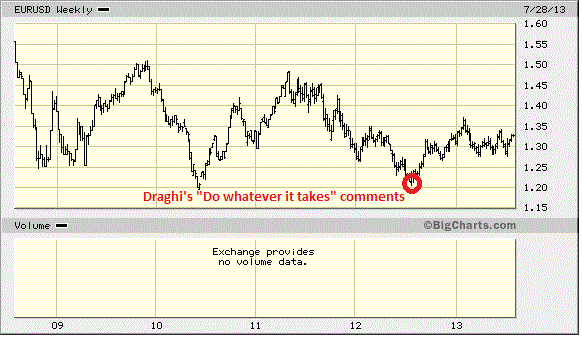By The Sizemore Letter
A year ago, European Central Bank chief Mario Draghi promised to “do whatever it takes” to save the euro. The reality is that he hasn’t done much of anything. He hasn’t had to.
The Outright Monetary Transactions bond-buying scheme—which was designed to calm the bond markets by buying potentially unlimited amounts of Eurozone periphery-country bonds in the secondary market—was put together after Draghi’s comments but has yet to be implemented. Its mere existence—and Draghi’s perceived eagerness to use it—were enough to put the bond market as ease.
In the year that has passed, the Spanish 10-year bond yield—which has become a de facto measure of investor sentiment towards the Eurozone—has collapsed from 7.8% to 4.6% at time of writing. It had fallen to as low as 4.0% in May, until Fed Chairman Ben Bernanke’s QE “tapering” comments caused a general world-wide hike in bond yields.
Italy’s bonds have fared even better. Despite a political crisis brewing in Italy that could see former prime minister Silvio Berlusconi jailed and barred from office—and bring down Italy’s coalition government in the process—Italy bond market remains healthy, and the 10-year yield sits at a manageable 4.4%.
As fears that the Eurozone would implode continued to build throughout late 2011 and the first half of 2012, the euro lost nearly 20% of its value relative to the dollar. But as fears of a meltdown receded, the euro rallied, notching up gains of about 13% vs. the dollar before settling into a trading range that has lasted for most of 2013.
So, where does the euro go from here?
There are a lot of moving parts, but let’s look at some of the most critical drivers one by one.
1.All else equal, an improving Eurozone economy should give investors faith that the worst is over for Europe. Improving sentiment means new money flowing into Europe…which should point to a stronger euro. On this count, we see what could be the first green shoots of recover. European oil consumption is rising for the first time in two years, and the Spanish unemployment rate—though still shockingly high at 26.3%–ticked down for the first time in two years last quarter.
2. The “carry trade” is a major determinant of currency moves. All else equal, higher-yielding currencies tend to rise relative to lower-yielding currencies. Currency traders short the lower-yielding currency and buy the higher-yielding currency, hoping to profit both from the spread between the two interest rates and from appreciation in their long currency. Right now, the Fed Funds rate is effectively zero (it’s official target is 0.00% – 0.25%). Bernanke has indicated that rates will remain close to these levels for “the foreseeable future,” which is taken to mean through at least the end of 2014.
The ECB’s target rate is slightly higher, at 0.50%, but not high enough for the spread to be much of a factor. At best, the euro is slightly less likely to be used as a funding currency than the dollar or yen. Overall, I consider the carry trade to be neutral for the euro.
3. Lower inflation generally leads to an appreciating currency, all else equal. And on this count, I see a mild positive for the euro. Inflation in the Eurozone can in at 1.6% last month, and core inflation was just 1.2%. In the U.S., the numbers were 1.8 and 1.6, respectively. I expect inflation to remain tame in both the U.S. and Europe, though when inflation does eventually start to trend upward again I expect it to happen in the U.S. first.
4. A positive trade balance is good for a currency, all else equal, and this metric favors the euro. While five years of economic malaise have brought the American current account deficit down to just 2.7% of GDP, the Eurozone has a current account surplus of about 2% of GDP.
The numbers suggest that the euro should enjoy modest gains against the dollar over the next year, or at the very least continue to trade near the upper end of its recent trading range. Of course, all of this could go out the window in an instant if Italy or Spain slide into political crisis again or if the bond markets revolt as they did early last year.
Trading “near the upper end of its recent trading range” is not a ringing endorsement of a long-euro trade. But given the likelihood of relative stability in the euro, a strong case can be made for European equities. Taken as a group, European stocks are substantially cheaper than their American counterparts and tend to pay higher dividends.
This article fist appeared on MarketWatch.
SUBSCRIBE to Sizemore Insights via e-mail today.
